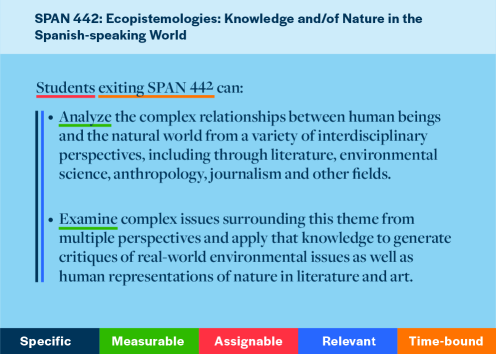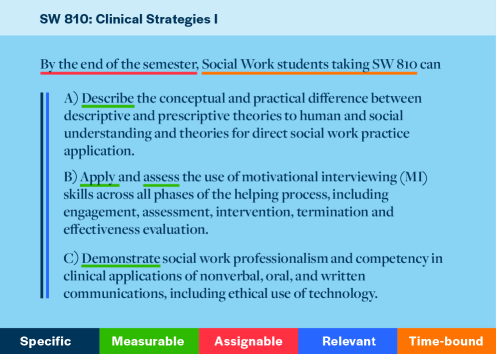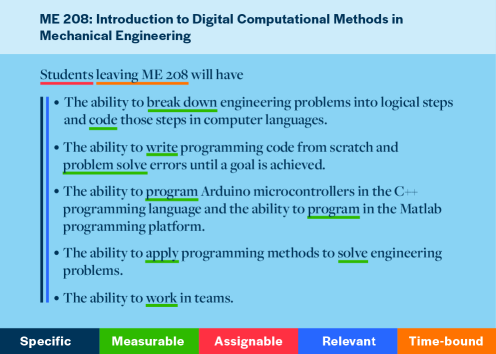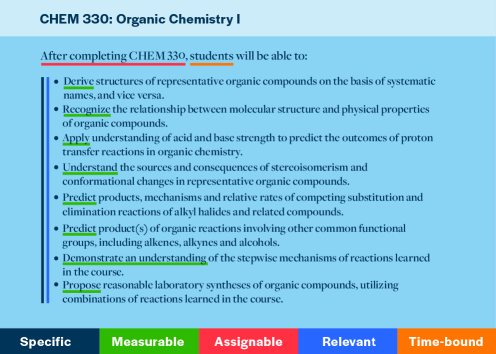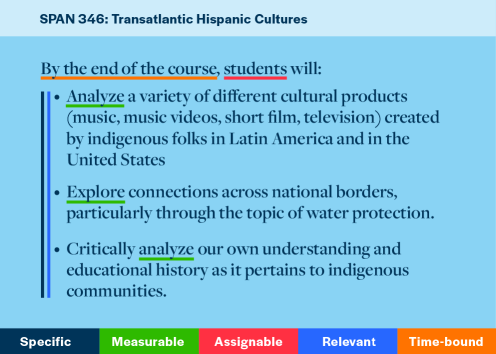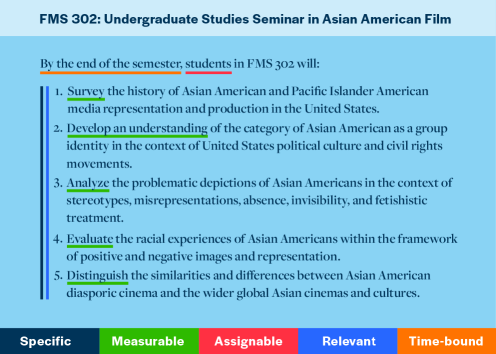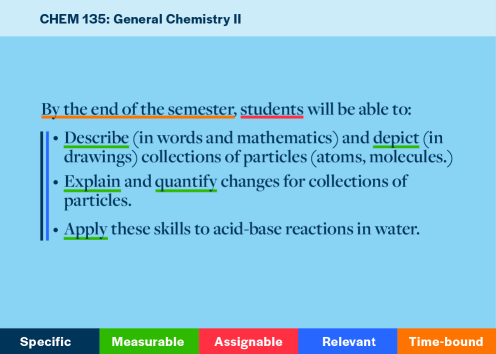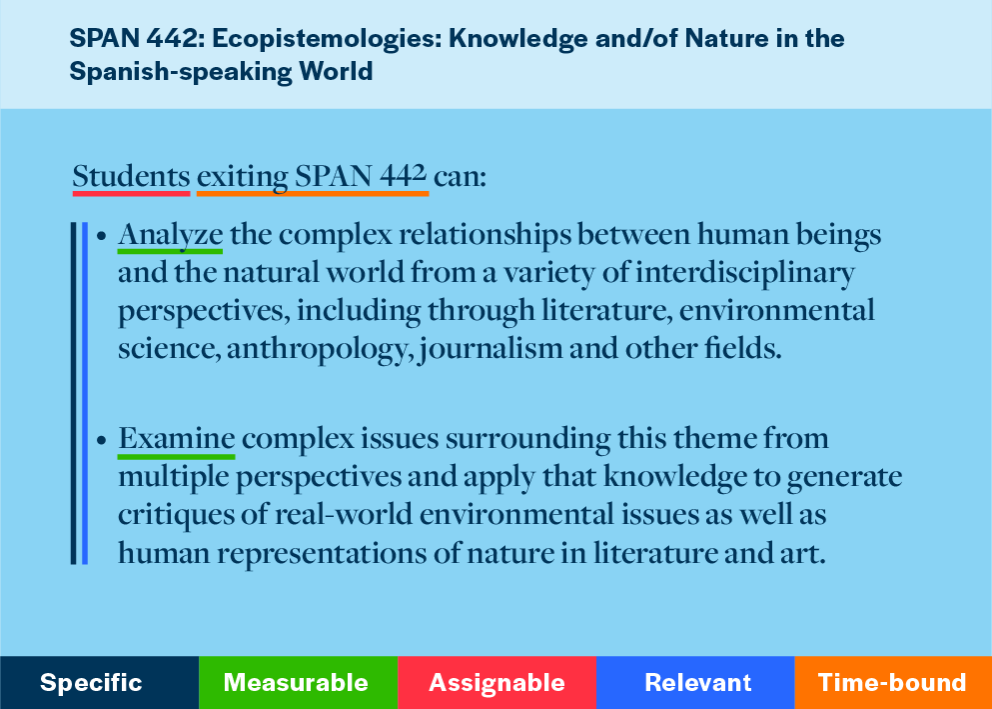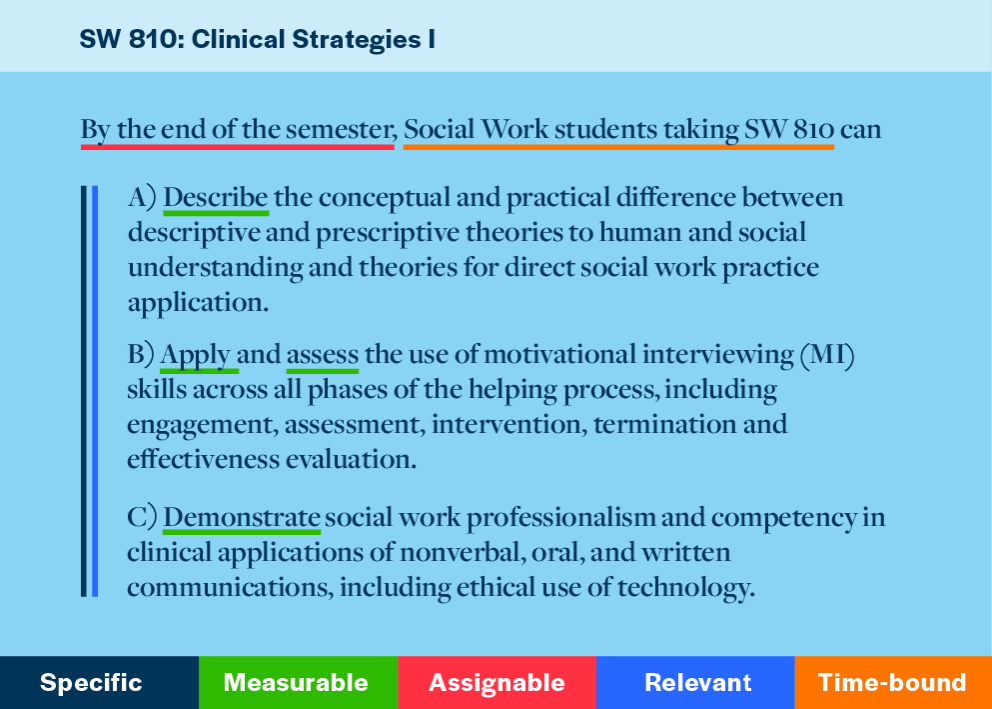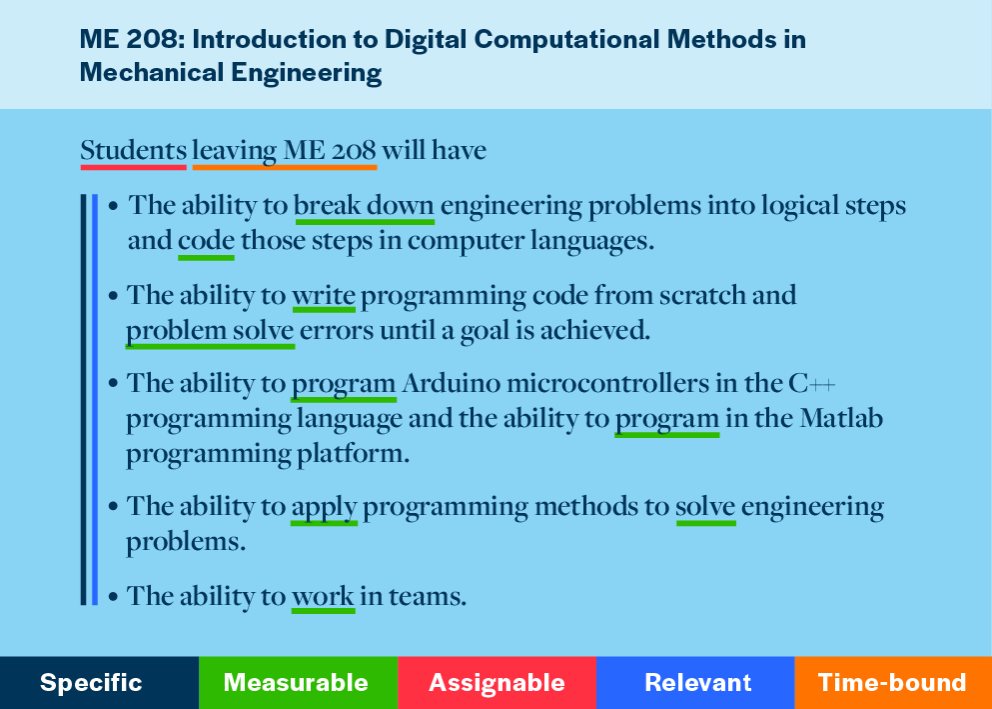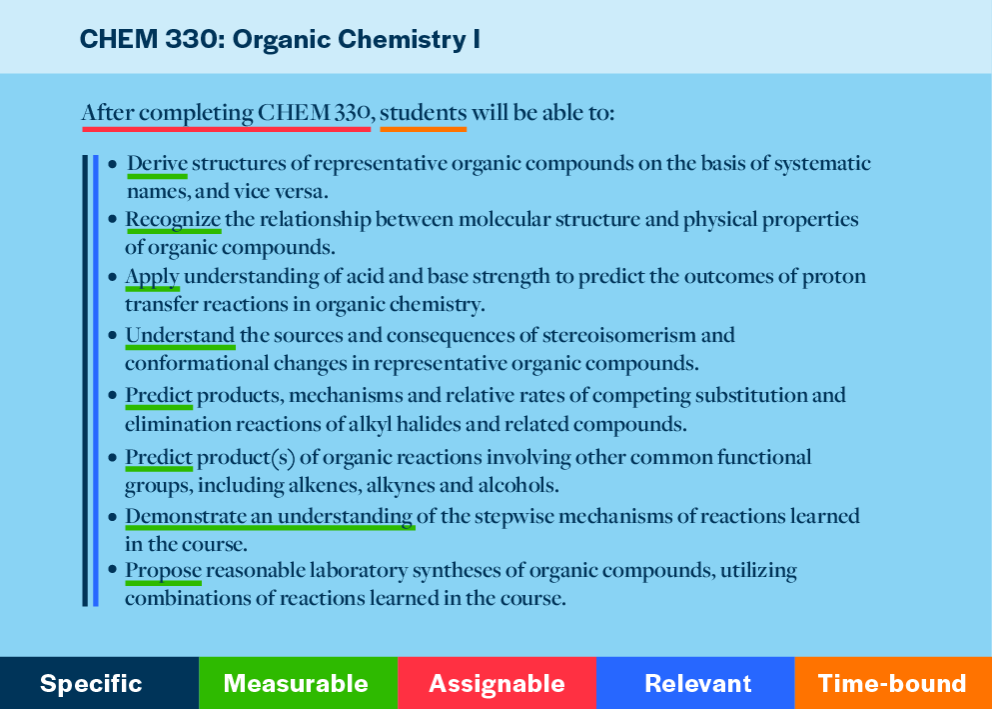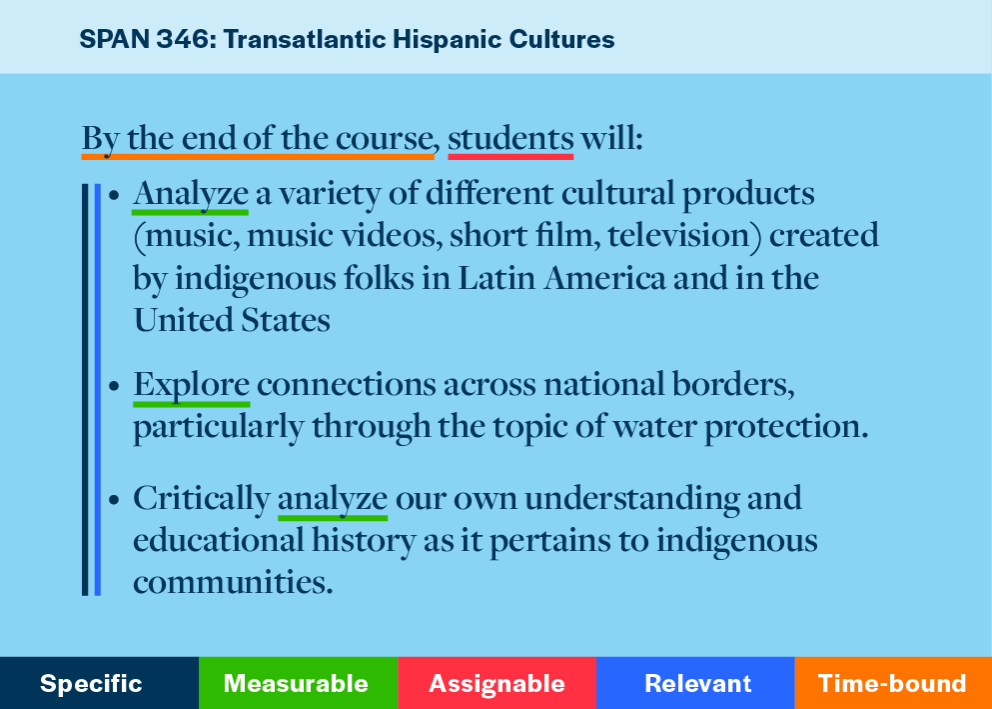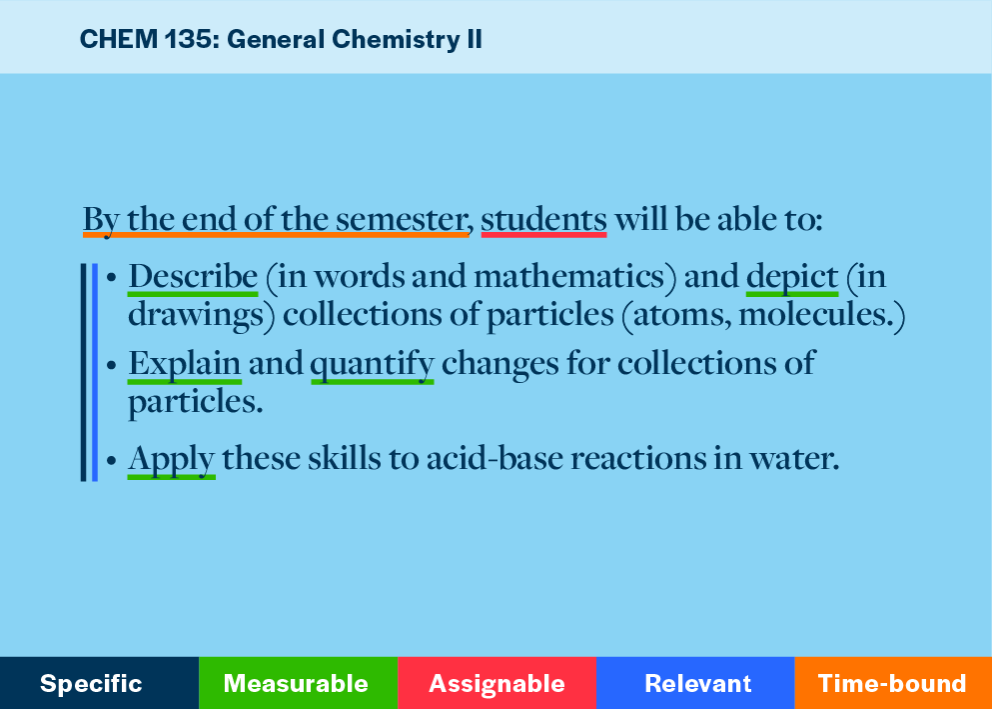Course Level Outcomes Guide
Overview of resources for course level outcomes
Starting with course-level learning outcomes
When writing learning outcomes for an individual course, knowing where to start can be challenging. The best advice by far is rooted in “Backward Design” (Wiggins & McTighe; 1998, 2005): Start with the end of the course in mind. You might ask yourself one or more the following questions and formulate concrete answers:
- By the end of this course, what skills or knowledge do I want students to be able to show? How do I ask students to show these skills or knowledge?
- At the course’s end, how would I articulate to a typical student what I hoped they got from the course?
- What skills or knowledge do students want to get from this course?
- What skills or knowledge are already housed in my course? How would I concisely describe the aggregate of those skills or knowledge?
- What skills or knowledge does my course bring to the overall degree? What student development is supposed to be happening in my course in service to the broader degree program?
- If students left my course with only 3-7 big takeaway skills or ideas, what would they be?
(Practitioners of assessment will note that this is the same framework recommended for degree-level outcomes applied to course-level outcomes instead.)
These are all different ways of framing the same overall question: What can students can do as a result of taking the course? Your answer to this will be one or more course-level learning outcomes.
Purpose and audiences for course outcomes
- clarify your values for yourself, your students, and others
- develop a stronger sense of purpose for the course
- more easily envision (potentially novel) student assignments or assessments
- provide a framework to sequence or organize skills or knowledge in the course
- maintain course focus:
- eliminate skills or knowledge that fall outside the scope of course outcomes
- amplify skills or knowledge that fall within the scope of course outcomes
- justify to various audiences different learning activities in the course
- know what’s important to the instructor
- see what they’ll get out of the course
- recognize what they need to do to satisfy course requirements
- differentiate between courses, programs, and institutions
- help students make selections and connections across courses in a curriculum
- identify opportunities for targeted student development in different courses
- better inventory the learning experiences students transferring into or out of the university bring or take with them
- better see differences and similarities among courses in the department
- determine where in the curriculum specific skills or knowledge are embedded
- identify collections of courses that initiate and successively build a particular skill or knowledge base
- address over- or under-emphases within a degree program
- consider how learning activities in external courses integrate into a degree program
- discover courses in other departments that may intersect well with their degree program
- uncover opportunities for cross-cutting, intersectional, or multidisciplinary skill-building
- catalog learning activities across the university
- characterize institutional strengths and weaknesses related to learning modes
- compare university-wide learning opportunities and structures to those of similar or aspirational institutions
- identify and articulate the institution’s value proposition
- determine the scope of learning activities at the institution
- declare standing of the institution relative to external education standards
Anatomy of a course outcome & relationship to assessment
The SMART framework (Doran, 1981) is a good, common way to think about the information content in a well-posed course learning outcome. Over the years, variability in the meaning for each letter has emerged; for example A is "assignable" here but might be "achievable" elsewhere. The version below helps faculty think about the scope of any course-level learning.
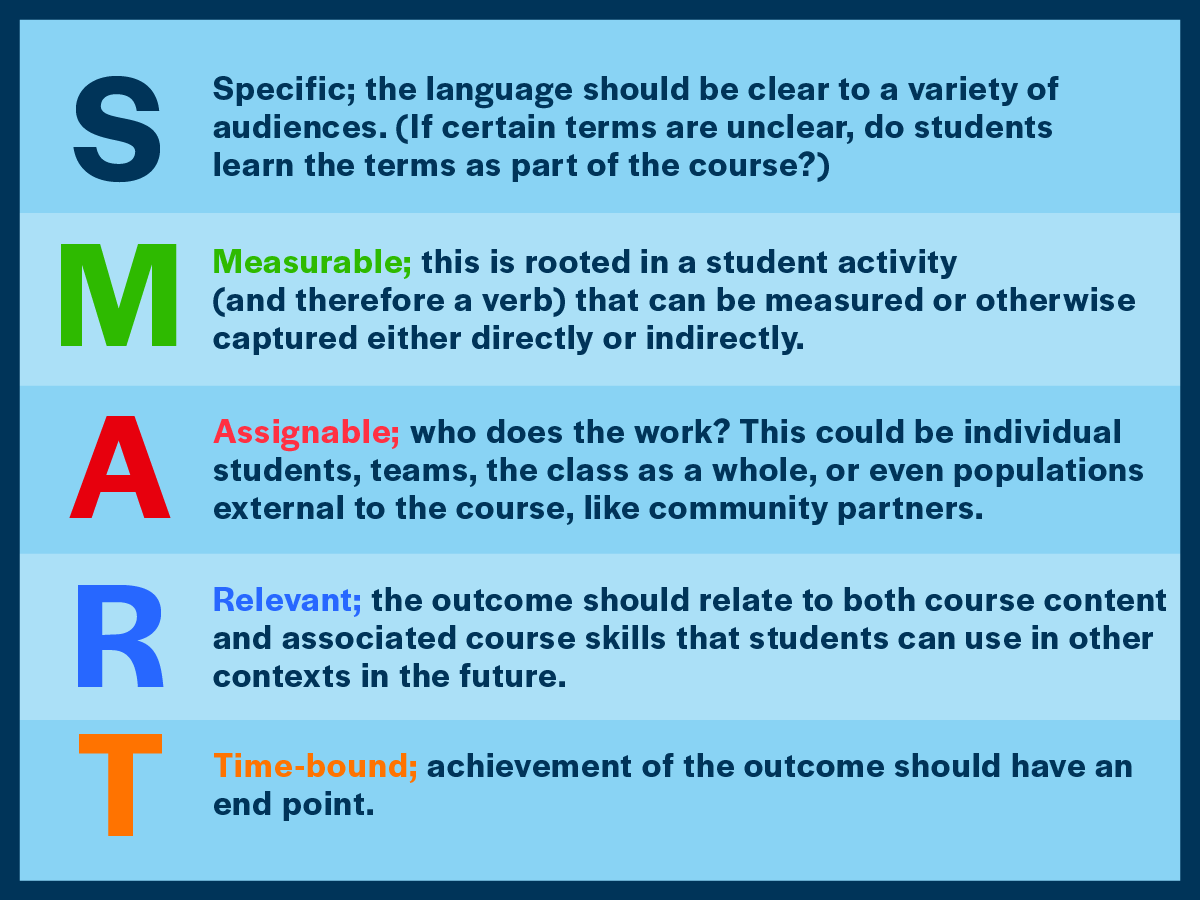
It is common for the assignable and time-bound aspects in many course outcomes to be left implied as "each student" and "by the end of the course."
Considerable attention is generally given to the "measurable" aspect of a SMART outcome, as this is both what students will do to show their learning and what instructors will evaluate to know if learning has occurred. A consequence of this importance is that lists of actionable and measurable learning verbs have been created: "taxonomies of learning." Some taxonomies, such as Bloom’s, are also hierarchies of cognitive activity. Course outcomes therefore are written to reflect higher levels of cognitive activity than outcomes for individual learning activities, class sessions, modules, or other course components. Below are just a few taxonomy resources that can be found on the web:
- Revised Bloom's Taxonomy: Carnegie Mellon University
- Bloom's Taxonomies (cognitive, affective, and psychomotor domains): University of Illinois Chicago
- Bloom's Digital Taxonomy: Arizona State University
- Fink's Taxonomy of Significant Learning: University of Delaware
Generally, broad verbs that are less obviously captured or measured (“understand,” “demonstrate,” “appreciate,” etc.) should be avoided for specific learning activities, class sessions, course modules, etc. However, at the scale of the course, such language becomes more permissible, particularly in combination with other verbs that provide a clearer indication of student activities. This is largely a result of the course summatively housing a broad array of many learning activities, skills, and knowledge: the course outcome can simultaneously be thought of as summatively housing a broad array of individual cognitive activities (lower-level outcomes.)
The relationship between outcomes and assessments is naturally strong: If you've articulated your values for student learning (outcomes), wouldn't you check that your students are, in fact, doing the type of learning you value (assessment)? Luckily, outcomes rooted in the SMART framework naturally inform assessment. Consider the following (fictitious) SMART outcome: "By the end of module 2 in PSYC 477, teams will view video of a fictitious family therapy session in combination with intake form data in order to analyze family dynamics through the lens of Bowlby and Ainsworth's Attachment Theory." Regardless of its particular format, the assignment should be created in a way that requires student teams to analyze the fictitious family, and each team's ability to do so should constitute the majority of the instructor's feedback. Because of this alignment between the outcomes and assessment, the instructor will know directly if the students are making progress toward the outcome.
Course Outcomes in Context
Two additional considerations can help you know if your course-level learning outcomes are functioning well: how they reflect the various learning activities of the course as a whole, and how they combine with outcomes in other courses to support the degree.
Course outcomes as aggregates of learning activity-level outcomes. Do the learning activities, class sessions, or modules and their associated outcomes relate directly to one or more course outcomes? In the same sense that the sum of learning experiences in a course constitutes the course itself, achievement of outcomes associated with learning experiences should equate to achievement of the outcomes for the course. A possible check on your backwards design of course outcomes, then, is to think forward for a moment. Consider the whole range of activities students engage in to show their learning in the course: Do they, in fact, sum to the course learning outcomes?
Course outcomes as elements of degree-level outcomes. Just as learning activity-level outcomes stand in service to one or more course-level outcomes, so do course-level outcomes stand in service of degree-level outcomes. A possible check on your course outcomes, then, is again to think forward momentarily. Does each of your course-level learning outcomes serve one or more degree-level outcomes? If a course outcome does not seem to serve any degree outcomes, is this intentional or accidental? In either case, what are the consequences for student learning?
| Checklist for finalizing your course outcomes | |
|---|---|
❏ | Does the learning outcome identify what students will be able to do summarily because of the myriad activities in the course, i.e., is it student-centered and reflective of a course focus? |
| ❏ | Is it clear how you would test achievement of the outcome? |
| ❏ | Does the chosen verb have a clear meaning? (Common terms that can lack clarity include “understand,” “demonstrate,” “appreciate,” etc.) If not, is there other language in the outcome that clarifies the meaning? |
| ❏ | Is the verb is aligned with the level of cognitive work expected of students? Could you expect a higher level of effort? |
| ❏ | Is the terminology in the learning outcome familiar/common? If not, is knowing the terminology an outcome? |
| ❏ | Is it possible to write the outcome so it is relevant and useful to students? |
Course Outcomes Clinic
To help you hone your skill with course outcomes, a series of fictitious example course outcomes are provided below. Read each and reflect on the quality of the course outcome: What are its strengths and weaknesses? What modifications, if any, you might make to it? While not comprehensive, some cursory thoughts can be found below each outcome.
Outcome Examples
In this introductory astronomy course, students will be exposed to the mathematics that governs the movements of the heavens.
- This is not a learning outcome. The wording involves students in a passive role. It is the instructor who exposes students to the mathematics, and therefore this is centered implicitly on instructor activities. If the statement instead addressed what students do with the information they're exposed to, it would qualify as a learning outcome. This should be revised to center the student's learning. For example, "Students will solve mathematical equations to predict the positions of the gas planets in the sky on the night before Stop Day" would be a student-centered outcome.
Apply basic principles of homeostasis as observed on Earth to envision and describe a fictitious astrobiological cell in terms of its imagined structure, function, and organization.
- This is a strong course outcome: Were one to think through this carefully, “envision,” in line with the “create” level of Bloom’s taxonomy, is a much higher-level cognitive function than “apply.” It may be an even stronger course outcome if written with the highest cognitive activity first: “Envision and describe a fictitious astrobiological cell in terms of its imagined structure, function, and organization by applying basic principles of homeostasis as observed on Earth.” In the revised course outcome, the ultimate deliverable comes first, with detail and support following. Note, too, that this is an outcome in which the "assignable" and "time-bound" elements of the goal are left implicit: One can assume these are "students" and "by the end of the course," respectively.
By the end of the semester in Modern Archaeological Techniques, students will plan, execute, and summarize an independent LIDAR analysis of the Black Jack battlefield near Baldwin City, KS at a level consistent with Professional Geologist standards.
- This is quite good and has all the hallmarks of a SMART goal (S=Specific, M=measurable, A=Assignable, R=Relevant, T=Time-bound.) An aside: If one tried to envision the student work taking place this semester, the highest cognitive activity might be the planning, which is abstract, while the greatest amount of time and effort might be spent on data analysis and interpretation, the summary. While cognitive level and time spent are often related, this is not always the case. That aside aside, this is a well-posed course outcome.
Exiting students demonstrate sufficient understanding of key principles of glass harmonica that apply to their own performances and those of major musicians.
- This reads like an assessment Boggle or Mad-Lib. Cleverly, many of the terms that frequently appear in assessment have been incorporated, but little to no sense can be made of this statement. Although not generally recommended, “demonstrate understanding” could be used with substantial clarifying detail. Instead, though, inserting the word “sufficient” further obfuscates the meaning. "Apply" here is used as a modifier that restricts which principles we're talking about; "apply" is not referring to a student cognitive activity. The question is still open: What are students doing that shows they understand? As worded, this outcome is confusing and does not clarify expectations for multiple audiences.
Students in the course will show understanding of elementary ancient Mesopotamian through their reading, translation, and summary of ancient Mesopotamian children’s stories.
- This is a well-written course outcome. It involves the word “understand,” but the meaning of that word is clarified through the inclusion of other skills at a similar level. In terms of providing a direct glimpse of student learning, the student activities that one can most readily use for assessment are “translate” and “summarize.” However, one could imagine read-aloud activities in class, via voice-capture software, or perhaps comprehension questions to examine certain skills associated with "read. Moreover, the level of this work is clear to an audience: this is intended to be introductory, as indicated by “elementary” and “children’s stories.” Overall, this outcome is well-crafted: students, advisors, faculty colleagues, administrators, and accreditors would all have a sense of the level students operate at by the end of the course.
Students completing WELL 450 will evaluate three recent wellness theories in terms of canonical work in the field, tracing lines of thought through the primary literature; students will analyze each theory for its integration of personal, social, medical, and spiritual components; students will describe elements and effects of wellness training.
- This is a compound goal. It can be tempting to say too much, and this can happen readily if one isn’t sure where to start. “If I throw everything into the outcome, some part of it is bound to fulfill this requirement, and the course will be good to go!” Interestingly, this reads a bit like the different levels of learning that might be associated with an outcome, starting with the highest level first. In the sense that student achievement of the highest level of learning is, ultimately, achievement of the parent outcome, perhaps the first statement becomes the outcome and the highest level of learning, with supporting levels of learning (intermediate, introductory) following. The student activities at each of these levels (evaluate, analyze, describe) would fit with this scheme (advanced, intermediate, introductory.)
Each student in a pair will draft a defensible legal contract between their client business and the opposing business.
- If this is a course on business contracts, perhaps this is a summative assignment that could, in fact, be used to gauge a student’s mastery of skills and concepts embedded in the course. Without this context, it is possible to read this as a project-level outcome. The word “draft” in particular makes it seem like the skill is in development, rather than completion. If this is a course-level outcome that reflects summative learning, could the learning take place at a much higher level simply by including one additional activity: Students then compare their drafts and dissect the strengths of each? Note, too, that one might assume that each student is evaluated based only on their work, but there's also the possibility that the pair of students could be evaluated together—the "assignable" aspect of a SMART goal.
Works Cited
Doran, G. T. (1981). There's a S.M.A.R.T. Way to Write Management's Goals and Objectives. Management Review, 70(11), 35-36. Return to text.
Wiggins, G., McTighe, J. (2005). Understanding by Design. Assn. for Supervision and Curriculum Development.
